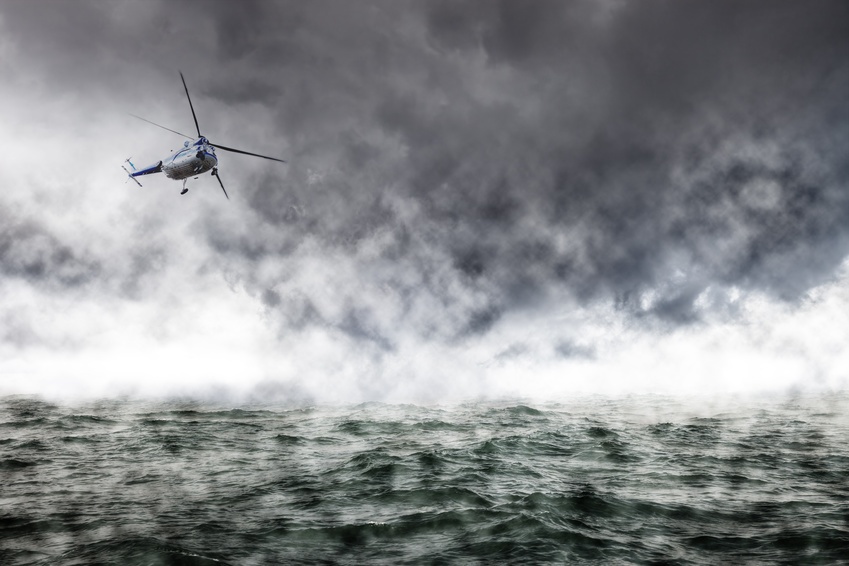The wind is blowing, the water is stormy, salt fills the air and you need to land an aircraft and bring it to safety. These challenging situations happen every day on offshore airports all around the world and they call for first-class ground support equipment that can handle the tough conditions at sea. These are the features you should pay attention to.
Why can’t a conventional aircraft tug operate offshore?
Wait. So I can’t just use a regular aircraft tug on an offshore platform or an aircraft carrier?
Well, of course, you could, but you would be seriously risking the safety of your aircrafts and your employees. There are many factors that make ground operations at sea an extraordinary endeavor:
- The tilting is ever-changing through unpredictable waves.
- There is only very little space.
- Waves can pour huge amounts of water on the runway.
- The salty and moist air is challenging for most conventional equipment and its technology.
Some organizations spare tugs at their offshore stations altogether but this can turn out as a dangerous trap. Imagine a helicopter blocks the only landing field at your platform and suddenly it breaks down. In case of an emergency a tug could tow it aside – or in a worst-case scenario into the ocean – to make way for a rescue helicopter. Otherwise, the platform would stay unreachable.
For a safe offshore operation: Features of an appropriate aircraft tug
Whether you work at an oil platform, on a military aircraft carrier or you own a private yacht – the requirements are the same. Here’s an overview.
1. Climate, water, and weather
The tug must be able to withstand extreme weather conditions. Puddles have to be as little of a deal for the equipment as humid and salty air. Slip-proof tires are a necessity here, otherwise, you risk your fleet sliding into the sea. And remember: The tug will get wet. If you don’t want your equipment to rust away, it should better be stainless. Special materials and varnish are a must-have.
2. Waves and inclined ground
At a normal hangar or airport, the apron usually has a 2% slope. The steeper it gets, the harder it is to tow the aircraft since its own weight is pulling it down the hill. When the sea is rocking the platform side to side, the tug must constantly switch between towing and breaking. So when your offshore runway is pitching and tossing, you need a strong tug with a backup plan. Tires with a high contact pressure are a good start. Furthermore, the Mototoks that we design for offshore operations have a special feature: a powerful magnet. In case of heavy turbulences, the tug clings to the floor and the airplane or helicopter it carries is safe and sound.
3. Agility and little space
A ship is bigger than a car, bigger than a house, some are even bigger than a 10-story building. But still, the space on deck is very limited compared to a normal airport. If you have a yacht with only one landing spot for helicopters you can’t maneuver however you like. Agility is key in these situations. Only a minimal turning circle and a complete freedom of movement provide swift and safe operations.
4. Safety certifications are a necessity
Offshore operations often come with extraordinary circumstances like special technologies or equipment that are also on the ship, or even dangerous substances. Therefore, you need an offshore aircraft tug that is certified to operate around these things. Two things are primarily important:
- The electrics have to be right. The tug must neither be distracted by any other equipment on the ship nor interfere with them.
- The tug needs to be absolutely explosion-proof. Especially if you are working at an offshore platform, this is an incredibly important point. If there are any flammable vapors or substances around, you are otherwise risking an explosion and a massive fire that can result in tremendous financial and personnel losses.
Conclusion to aircraft tugs for offshore operations
Normal pushback operations are nothing compared to towing an airplane or a helicopter at sea. Therefore, a conventional tug will always be a poor choice for offshore operations. Pick an aircraft tug that has safety certifications and is specifically built for this area of application. Currently there are only two manufacturers for this type of equipment worldwide, Mototok is one of them.
Get in touch with us right now and find the perfect solution for your offshore operation.


Comments